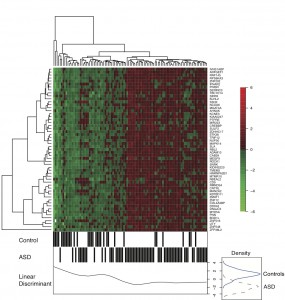
A “heat map” for autism gene expression (click to enlarge). Each row represents one of the 55 genes differently expressed in ASD patients vs. controls; columns show expression profiles for each of the 99 subjects. Genes in red have relatively increased gene activity; green, reduced activity. The bars along the bottom show how ASD patients vs. controls are distributed; overall, the ASD group has more genes over-expressed, while the control group has more down-regulated. The brackets at left connect genes that tend to be expressed together, while those along the top link individuals with similar gene expression patterns.
Though autism can respond well to early behavioral interventions, it’s typically not diagnosed in the U.S. until around age 5, when these interventions are less effective. Autism is diagnosed based on a child’s behaviors and language, which take time to develop to the point where clinicians can reliably assess them. What’s really needed is a fast, objective test when a child is much younger, before symptoms even show up.
In the past decade, researchers have chipped away at the problem, linking more than a dozen genetic mutations to autism—from small DNA “spelling” changes to lost or extra copies of a gene or genes (known as copy number variants) to wholesale chromosome abnormalities. Tests have been created, such as the chromosomal microarray test. But together, the known mutations account for, at best, 1 in 5 autism cases among tested patients. Full story »







